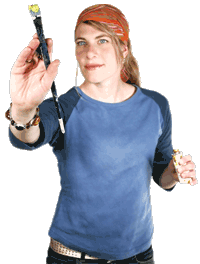At HomeQuestionsAnswered, we're committed to delivering accurate, trustworthy information. Our expert-authored content is rigorously fact-checked and sourced from credible authorities. Discover how we uphold the highest standards in providing you with reliable knowledge.
What is a Harlequin Pattern?
A harlequin pattern is a repeating pattern of contrasting diamonds or elongated squares standing on end. Traditional clown suits are made in a red and white diamond pattern, named after the historical comedic character that made the pattern so well known.
The harlequin pattern originated 400 years ago on Italy's theatrical stages, where performers who had honed their acts on the street would engage in improvisational comedy. Standard themes at the time were based around stock characters and situations — shortsighted, arrogant masters and inept, bumbling servants. Harlequin was a "servant" who wore brightly colored diamond-patterned tights and a mask. The pattern has been associated with clowns ever since.

Because of the pattern's clownish associations, it is not generally popular in clothes. However, variations on the theme, such as muted earth tones used in woven sweaters, often feature a single vertical line, encircling line, or partial harlequin pattern. Ski clothing, which tends to be colorful as a safety feature, is sometimes made in a traditional diamond pattern of red and white or other bright combinations.
However, the harlequin pattern is beautiful in areas other than clothing, such as stoneware or inlaid wood. Antique tables, dressers and chests, as well as modern floors and finely crafted furniture, often feature the pattern. Decorative dresser-top boxes are also often inlaid with these diamonds.
As an aside, it may be interesting to note that the Italian-based character brought us something besides the harlequin pattern that has endured. He held a length of double-lathe wood, sometimes wrongfully depicted as a sword. The lathe was used as a paddle to gleefully smack fellow actors on the rump. The paddle made a loud "slap" that gave rise to the name "slapstick." With antics appealing enough to endure through centuries, this original form of slapstick would set the stage for Vaudeville acts to follow.
It may be no wonder then, that standing the testament of time, today's party-clown-for-hire might also show up in a clown suit of the traditional harlequin pattern. After all, if it worked for the original...
AS FEATURED ON:
AS FEATURED ON:










Discuss this Article
Post your comments